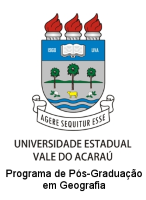TIME, SPACE, AND CAUSALITY IN GEOMORPHOLOGY
Resumo
The distinction between cause and effect in the development of landforms is a function of time and space (area) because the
factors that determine the character of landforms can be either dependent or independent variables as the limits of time and
space change. During moderately long periods of time, for example, river channel morphology is dependent on the geologic
and climatic environment, but during a shorter span of time, channel morphology is an independent variable influencing the
hydraulics of the channel.
During a long period of time a drainage system or its components can be considered as an open system which is
progressively losing potential energy and mass (erosion cycle), but over shorter spans of time self-regulation is important,
and components of the system may be graded or in dynamic equilibrium. During an even shorter time span a steady state may
ex1st. Therefore, depending on the temporal and spacial dimensions of the system under consideration, landforms can be
considered as either a stage in a cycle of erosion or as a system in dynamic equilibrium.
Downloads
Publicado
Como Citar
Edição
Seção
Licença
This work is licensed under a Creative Commons Attribution 4.0 International License.
Autores que publicam nesta revista concordam com os seguintes termos:
- Autores mantém os direitos autorais e concedem a William Morris Davis o direito de primeira publicação, com o trabalho simultaneamente licenciado sob a Creative Commons Attribution License (CC-BY 4.0), que permite o compartilhamento do trabalho com reconhecimento da autoria do trabalho e publicação inicial nesta revista.
- Autores têm autorização para assumir contratos adicionais separadamente, para distribuição não-exclusiva da versão do trabalho publicada nesta revista (ex.: publicar em repositório institucional ou como capítulo de livro), com reconhecimento de autoria e publicação inicial nesta revista.
- Autores têm permissão e são estimulados a publicar e distribuir seu trabalho online (ex.: em repositórios institucionais ou na sua página pessoal) após o processo editorial, já que isso pode aumentar o impacto e a citação do trabalho publicado (Veja O Efeito do Acesso Livre).
- Autores são responsáveis pelo conteúdo constante no manuscrito publicado na revista.







